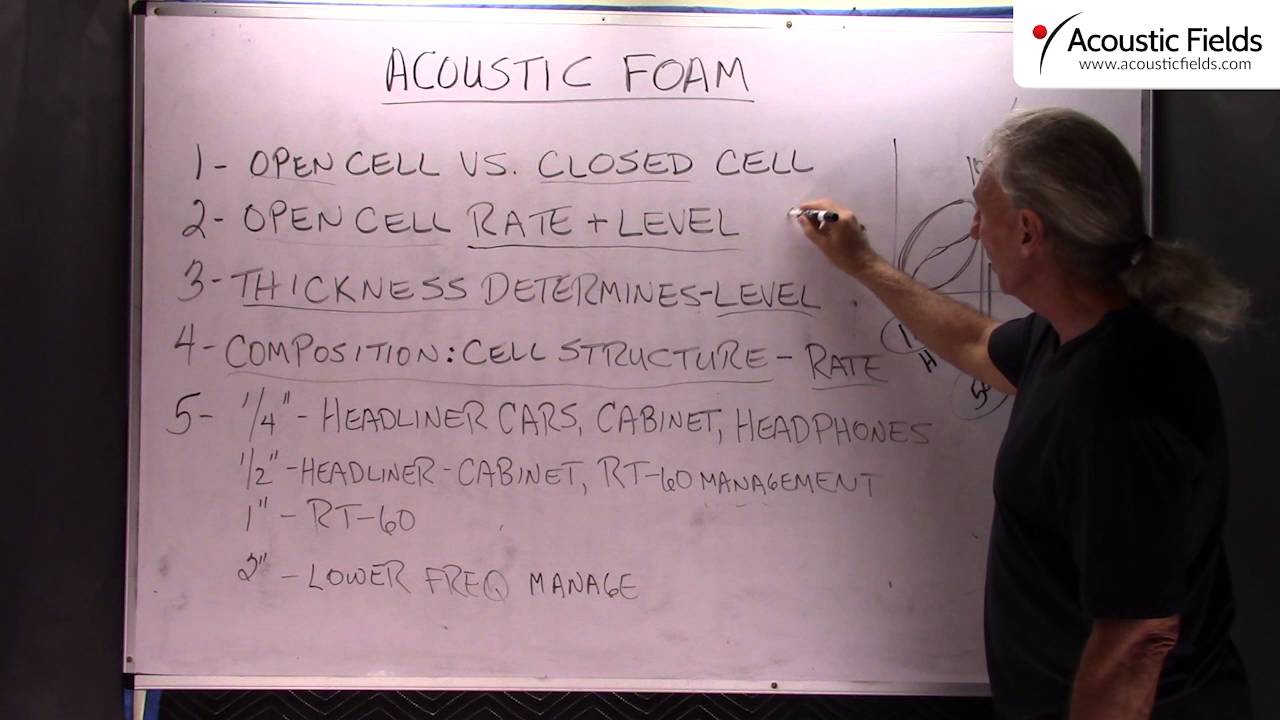Acoustic foam comes in two types, open cell and closed cell and there’s some confusion I see in my inbox about that so let’s walk through the differences. Open cell foam is exactly what the name implies. The cells are open which allows for air movement to get inside each cell, move around, create friction, transform to heat and then we have the energy change.
Closed cell foam is the kind of foam you use in seat cushions, pillows, things like that. Your car seats. Closed versus open I think is the best way to think about it. Open is something we use in acoustics, closed is something that you sit on. So that would be a good way to think about it.
The thing about open cell foam is it’s very light weight and it’s very economical. So you can get managed and controlled rates and levels of absorption if you do your research and you come up with a technology that works for you. So rate and level of absorption are the most critical points with any kind of sound absorption product. And open cell foam is no exception.
So the thickness of the foam, it determines the level or how low the foam will absorb that. I know we see a lot of claims and representations in the literature where foam absorbs low frequency and if I ever see that again I think I’m going to scream and run down the street because it does not work for low frequency. Let’s get that clear from the beginning. No matter how much these companies bend and twist their definitions of low frequency.
So it’s the thickness that determines the rate and level. Now most foams start at the 125 cycle range. And then they go up all the way through 6,000 on the average. But there is a big break point here at 500. Most are at 100% after 500. But the real key to the rate and level of absorption is these frequencies below 500.
So that’s what you want to look at and you can examine our curves and they were specifically designed – I mean it took me 8 years to figure out these curves with foam. Because when you manufacture foam, it’s all about temperature, viscosity, thickness, all kinds of variables that you have to take into consideration to determine rate and level.
So you have to spend time figuring it out. But we’ve chosen a rate and level that’s really smooth here from 125 to 500. And that’s wonderful for vocals and music in general. So our foam is specifically designed with absorption curves that are complimentary to music and voice, not going against it.
So the cell structure of the foam, that determines the rate or how much absorption occurs within that thickness. Our cell structure is very unique, it’s more like a honeycomb structure. So all the cells fit together and you get a nice composition where everything works together – I’m a terrible artist sometimes – but I think you get the idea that all the cells are pretty consistent in shape and form and work together.
So level and rate, those are the two things you look for. And since thickness controls the level or how low it goes, we manufacture four types. We manufacture a quarter inch, half inch, one inch, and two inch thicknesses.
The one quarter inch, you use it in headliners of cars, cabinets, lining the insides of cabinets. Speakers even. But a lot of people use it for lining the inside of their headphones. And we have a couple of headphone manufacturers that purchase our quarter inch on a regular basis.
Half inch, a little bit thicker, so we’re going to get a little bit more here with thickness, we’re going to get a little bit more absorption below 500. So once again headliner, cabinet, RT-60 management on some room surfaces.
The quarter inch and half inch are not used too much in room acoustics, we mainly use our one and two inch. Obviously the two inch is getting down lower because of its thickness and the one inch we use for management of RT-60 times and calculations like that.
So four different thicknesses, four different rates and levels, open cell foam, that’s what you want to look for. And acoustic foam is a really light weight inexpensive way to manage your low frequency reflections.
Now, let’s take a peek here. It’s something people miss. People are like well I don’t want to cover my wall surfaces with a lot of foam. Okay, well then, how do you do that? You have to realize that foam has absorption qualities and properties on both sides of it. So whenever you work with foam, you always want to allow the air movement on both sides of the foam to occur. This minimizes the surface area requirements and the amount of product that you have to purchase and thus the amount of coverage you use in your room.
So our foam comes with a mount that purposely keeps it away from the wall 2 inches which allow us for proper air flow on both sides, reducing the number of pieces that you have, your costs and the covering of the surface area.
So keep it in mind, acoustic foam is a great way for middle and high frequency absorption if that’s your requirement within your room.
—
This is an unedited transcript from our video series from Acoustic Fields. There will be some errors in grammar and sentence structure that occur during this translation process.
For complete understanding and comprehension, please view the video which is included in this text. For any additional information regarding this topic or others relating to room acoustics, please contact us directly at:
P: 520 – 392 – 9486







